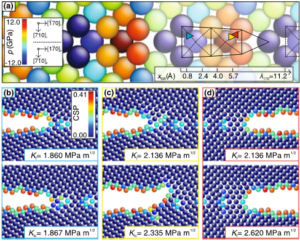Johannes Möller
Dr.-Ing. Johannes Möller
Project description
Former project: Atomistic simulations of intergranular fracture
Project area: B6
Supervisor: Prof. Dr.-Ing. Erik Bitzek
Grain boundaries (GBs) are commonly regarded as weak paths for fracture. Knowledge about the fracture behavior of GBs is therefore of particular importance for GB engineering of strong and tough structural materials as well as for continuum models of intergranular fracture, which allow to investigate failure of polycrystalline materials at the macroscale. Although crack propagation in single crystals has been studied in detail at the atomic scale, comparatively few atomistic studies exist on GB fracture [1]. In this subproject of project area B: “Mechanical Properties of Interfaces” and in association with the DFG priority program “Life∞ – infinite lifetime of high-performance materials subjected to cyclic loading” (SPP 1466) we studied the nucleation and propagation of GB cracks in body-centered cubic (bcc) metals with molecular dynamics and statics simulations in two and 3 dimensions.
Within this project, we could show that the fracture toughness of GBs depends on the exact location of the crack tip within the structural units of the GB, see Fig. 1, and that the toughest structural unit dominated the overall fracture toughness. The toughness furthermore depends on the propagation direction of the crack, even in case of purely brittle crack propagation, and GB fracture toughness values which were higher than the fracture toughness of a single crystal were measured. All these observations could be explained by extending the concept of lattice trapping to bond trapping in GBs [2]. In addition, we studied the nucleation of cracks at defect-containing GBs and could provide estimates for the theoretical tensile strengths of GBs and for the critical stress to initiate cracks at GBs in front of localized dislocation structures, which can be used for analytical and numerical models of crack initiation [3].

Fig. 1: Grain boundary structure and position as well as direction dependent fracture toughness: a close-up of a Σ25(710)16.3◦/[001] GB in W showing the structural units (atoms colored according to the local pressure). b and c show the crack tip located at different positions within the GB at a load where the crack tip is stable (upper panels) or has propagated (lower panels). d shows the crack tip at the same position as in c, however with opposite crack front direction, for which the crack remains stable at higher loads. Atoms in b–d are colored according to the centro-symmetry parameter. Reproduced from [1].
References
[1] E. Bitzek et al., Int. J. Fract. 191 (2015) 13.
[2] J. J. Möller, E. Bitzek, Acta Mater. 73 (2014) 1.
[3] J. Bach et al., Int. J. Fatigue 93 (2016) 281

